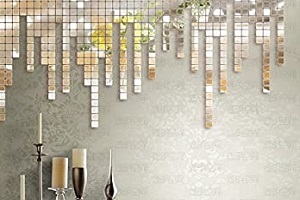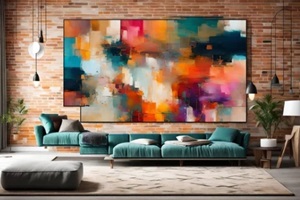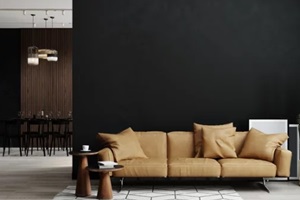 Businesses and homes both face struggles with how rooms are decorated. While large rooms can provide wide expanses for entertaining guests, serving customers, or creating a personal oasis, they come with another problem: noise.
Businesses and homes both face struggles with how rooms are decorated. While large rooms can provide wide expanses for entertaining guests, serving customers, or creating a personal oasis, they come with another problem: noise.
Larger spaces tend to be louder, and sometimes, no amount of furniture or carpeting can dampen the sound.
Acoustic wall art is an effective option that many business and residential owners do not realize exists, and it solves the problem of excess noise and echoes while offering an appealing aesthetic.
Understanding Acoustic Wall Art
Acoustic wall art is a type of art installation that serves a dual purpose: visual design and auditory function. The artwork can be customized to suit any space’s needs, but beyond the appeal of the canvas or panel, the wall art also alters how sound bounces around the room.
Sound waves cause excessive noise and echoes as they meet smooth surfaces. Without texture or absorbent material, the sound waves bounce back into the room, where they are picked up again by the ears of anyone inside.
However, acoustic wall art provides a surface that stops sound waves from reflecting back into the room. This dampens noise without harming the quality of people’s speech, music, and more.
Function and Design as a Joint Use
One of the main appeals of acoustic wall art is that it serves the dual purpose of visual decoration and functional application. Wall art is often customizable, enabling home and business owners to use photos, artwork, patterns, and designs that complement their goals.
Whether trying to match a focal centerpiece or replicating a design that is uniquely theirs, anyone can achieve design and functional goals using acoustic wall art.
Spatial Perception and Strategic Sound Mitigation
The types of artwork used in acoustic art will impact how visitors perceive the space. Use this to your advantage when creating a room that is more audibly comfortable and pleasing to the eye. For example, consider what role the wall art plays in the perceived orientation and flow of the space.
 Using acoustic wall art with a vertical-oriented design, such as upward stripes, images of trees, or gradients that get lighter as they get higher, can give viewers the sense that the room is tall, or it may direct their attention upward.
Using acoustic wall art with a vertical-oriented design, such as upward stripes, images of trees, or gradients that get lighter as they get higher, can give viewers the sense that the room is tall, or it may direct their attention upward.
Similarly, using horizontal patterns such as long bars of colors, pictures depicting horizontal images, and more may draw people into the room, giving it a sense of depth and distance.
As before, these images can also draw a person’s eye toward a specific feature or element — all while simultaneously preventing the space from getting too loud.
Subliminal Purpose and Décor
Another factor to consider when creating custom acoustic wall art is the designs’ subliminal purposes. Do not simply leave your acoustic art to handle the sound challenges in the room; carefully select a color palette as well because it will impact how people feel in the space.
Understanding color psychology is useful here. Some of the most common associations are:
- Red – Correlated with energy, using red in artwork can convey a sense of authority, inspiration, and determination. However, too much can feel aggressive or even dangerous.
- Yellow – This bright color is associated with happiness, openness, and joy. However, it is bright enough to cause discomfort if used in excess.
- Green – A natural color, green contributes feelings of freshness, connection with nature, and responsibility. However, too much green can make a space feel sickly or dirty.
- Blue – Blue is the color of trust and serenity. It is often selected for professional settings and areas where relaxation and comfort are paramount. Too much blue can make people feel sad.
- Black – Black is a modern color that conveys trendiness, professionalism, and tact. Still, too much black can make a space feel oppressive and claustrophobic.
Artwork as a Tool
One method of leveraging acoustic wall art for two purposes at once is by marrying positioning with aesthetic value. Acoustic panels are ideally installed across from noise sources, usually at eye level.
However, every installation is unique, and installing the wall art in the appropriate location for sound mitigation also opens up opportunities to reimagine the space visually.
 For instance, suppose that the acoustic panels must be installed high in the room according to that room’s soundscape. Remembering the principles of spatial perception, lighter colors higher in a room can make a room look taller or more open; this is why ceilings are often a lighter color than walls.
For instance, suppose that the acoustic panels must be installed high in the room according to that room’s soundscape. Remembering the principles of spatial perception, lighter colors higher in a room can make a room look taller or more open; this is why ceilings are often a lighter color than walls.
Leverage this knowledge to choose wall art that accomplishes an aesthetic purpose alongside its noise mitigation function.
Try Acoustic Wall Art in Your Space
Acoustic wall art is a powerful method of unifying your aesthetic vision with the functional needs of your space. By limiting sound, you make visitors and guests more comfortable while simultaneously treating them to décor that is uniquely you.
Contact Tree Towns to share your vision and learn how acoustic wall art can fit into your space.
